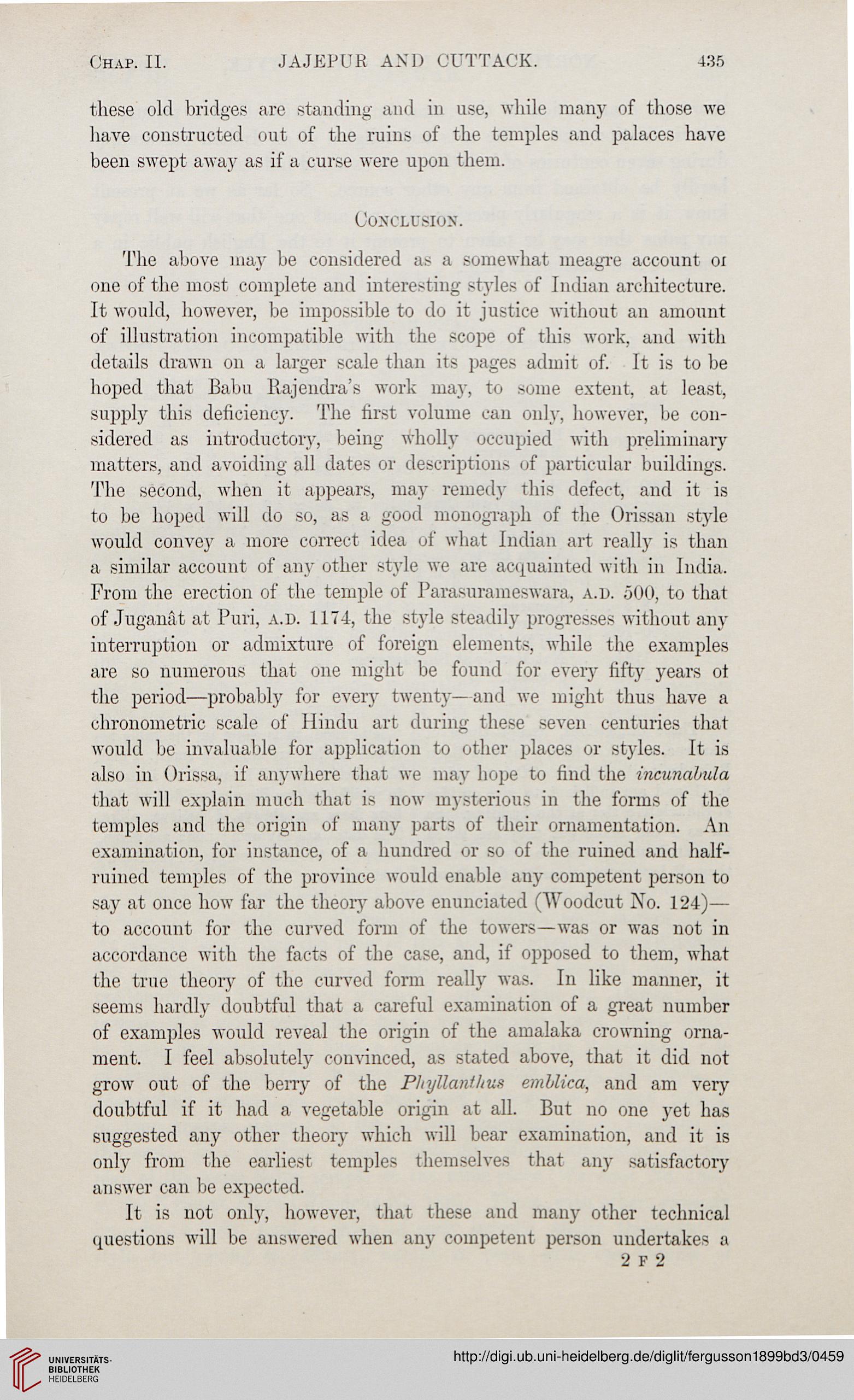Chap. II.
JA.JEPUR AND CUTTACK.
435
these old bridges are standing and in use, while many of those we
have constructed out of the ruins of the temples and palaces have
been swept away as if a curse were upon them.
Conclusion.
The above may be considered as a somewhat meagre account 01
one of the most complete and interesting styles of Indian architecture.
It would, however, be impossible to do it justice without an amount
of illustration incompatible with the scope of this work, and with
details drawn on a larger scale than its pages admit of. It is to be
hoped that Babu Bajendra's work may, to some extent, at least,
supply this deficiency. The first volume can only, however, be con-
sidered as introductory, being wholly occupied with preliminary
matters, and avoiding all dates or descriptions of particular buildings.
The second, when it appears, may remedy this defect, and it is
to be hoped will do so, as a good monograph of the Orissan style
would convey a more correct idea of what Indian art really is than
a similar account of any other style we are acquainted with in India.
From the erection of the temple of Parasurameswara, a.d. 500, to that
of Juganat at Puri, a.d. 1174, the style steadily progresses without any
interruption or admixture of foreign elements, while the examples
are so numerous that one might be found for every fifty years ot
the period—probably for every twenty—and we might thus have a
uhronometric scale of Hindu art during these seven centuries that
would be invaluable for application to other places or styles. It is
also in Orissa, if anywhere that we may hope to find the incunabula
that will explain much that is now mysterious in the forms of the
temples and the origin of many parts of their ornamentation. An
examination, for instance, of a hundred or so of the ruined and half-
ruined temples of the province would enable auy competent person to
say at once how far the theory above enunciated (Woodcut No. 124)—
to account for the curved form of the towers—was or was not in
accordance with the facts of the case, and, if opposed to them, what
the true theory of the curved form really was. In like manner, it
seems hardly doubtful that a careful examination of a great number
of examples would reveal the origin of the amalaka crowning orna-
ment. I feel absolutely convinced, as stated above, that it did not
grow out of the berry of the Pliyllanfhus emblica, and am very
doubtful if it had a vegetable origin at all. But no one yet has
suggested any other theory which will bear examination, and it is
only from the earliest temples themselves that any satisfactory
answer can be expected.
It is not only, however, that these and many other technical
questions will be answered when any competent person undertakes a
2 F 2
JA.JEPUR AND CUTTACK.
435
these old bridges are standing and in use, while many of those we
have constructed out of the ruins of the temples and palaces have
been swept away as if a curse were upon them.
Conclusion.
The above may be considered as a somewhat meagre account 01
one of the most complete and interesting styles of Indian architecture.
It would, however, be impossible to do it justice without an amount
of illustration incompatible with the scope of this work, and with
details drawn on a larger scale than its pages admit of. It is to be
hoped that Babu Bajendra's work may, to some extent, at least,
supply this deficiency. The first volume can only, however, be con-
sidered as introductory, being wholly occupied with preliminary
matters, and avoiding all dates or descriptions of particular buildings.
The second, when it appears, may remedy this defect, and it is
to be hoped will do so, as a good monograph of the Orissan style
would convey a more correct idea of what Indian art really is than
a similar account of any other style we are acquainted with in India.
From the erection of the temple of Parasurameswara, a.d. 500, to that
of Juganat at Puri, a.d. 1174, the style steadily progresses without any
interruption or admixture of foreign elements, while the examples
are so numerous that one might be found for every fifty years ot
the period—probably for every twenty—and we might thus have a
uhronometric scale of Hindu art during these seven centuries that
would be invaluable for application to other places or styles. It is
also in Orissa, if anywhere that we may hope to find the incunabula
that will explain much that is now mysterious in the forms of the
temples and the origin of many parts of their ornamentation. An
examination, for instance, of a hundred or so of the ruined and half-
ruined temples of the province would enable auy competent person to
say at once how far the theory above enunciated (Woodcut No. 124)—
to account for the curved form of the towers—was or was not in
accordance with the facts of the case, and, if opposed to them, what
the true theory of the curved form really was. In like manner, it
seems hardly doubtful that a careful examination of a great number
of examples would reveal the origin of the amalaka crowning orna-
ment. I feel absolutely convinced, as stated above, that it did not
grow out of the berry of the Pliyllanfhus emblica, and am very
doubtful if it had a vegetable origin at all. But no one yet has
suggested any other theory which will bear examination, and it is
only from the earliest temples themselves that any satisfactory
answer can be expected.
It is not only, however, that these and many other technical
questions will be answered when any competent person undertakes a
2 F 2




